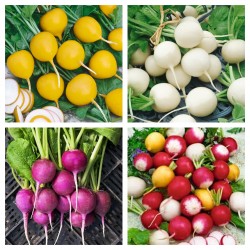Menu
-
MenuInapoi
- Home
-
Categorii
-
-
Categorii
-
Semințe de legume
-
Soiuri după țară
- Soiuri din Armenia
- Soiuri din BiH
- Soiuri din Croația
- Soiuri din Franța
- Varieties from Germany
- Varieties from Greece
- Varieties from Hungary
- Soiuri din India
- Varieties from Italy
- Soiuri din Japonia
- Soiuri din Macedonia de Nord
- Varieties from Peru
- Varieties from Russia
- Varieties from Serbia
- Soiuri din Slovenia
- Varieties from Spain
- Varieties from Thailand
- Soiuri din Turcia
- Varieties from USA
- Semințe de roșii
- Semințe de porumb
- Familia Dovleac
- Familia Bean
- Semințe de castraveți
- Seminte de ardei gras
- Familia morcovului
- Familia ceapa
- Semințe de salată verde
- Familia cartofilor
- Familia de varză
- Semințe de ridiche
- Familia sfeclei
- Semințe de pepene verde
- Semințe de pepene galben
- Semințe de conopidă
- Familia de floarea soarelui
-
Soiuri după țară
- Semințe de fructe
- Seminte de Chili Peppers
- Semințe de plante medicinale
- Semințe de plante cățărătoare
- Copaci - Arbust - Semințe
- Semințe de palmier
- Semințe de ierburi ornamentale
- Semințe de tutun
-
Semințe de legume
-
-
-
-
- PRODUSE NOI
- Crează un cont
- Livrare - Plata
- FAQ
- Acasa
-
- Pachete mari de semințe
- Semințe de plante uriașe
- Semințe de legume
- Soiuri după țară
- Soiuri din Armenia
- Soiuri din BiH
- Soiuri din Croația
- Soiuri din Franța
- Varieties from Germany
- Varieties from Greece
- Varieties from Hungary
- Soiuri din India
- Varieties from Italy
- Soiuri din Japonia
- Soiuri din Macedonia de Nord
- Varieties from Peru
- Varieties from Russia
- Varieties from Serbia
- Soiuri din Slovenia
- Varieties from Spain
- Varieties from Thailand
- Soiuri din Turcia
- Varieties from USA
- Semințe de roșii
- Semințe de porumb
- Familia Dovleac
- Familia Bean
- Semințe de castraveți
- Seminte de ardei gras
- Familia morcovului
- Familia ceapa
- Semințe de salată verde
- Familia cartofilor
- Familia de varză
- Semințe de ridiche
- Familia sfeclei
- Semințe de pepene verde
- Semințe de pepene galben
- Semințe de conopidă
- Familia de floarea soarelui
- Soiuri după țară
- Semințe de fructe
- Seminte de Chili Peppers
- Semințe de plante medicinale
- Semințe de plante cățărătoare
- Copaci - Arbust - Semințe
- Semințe de banane
- Semințe de palmier
- Semințe de ierburi ornamentale
- Semințe de tutun
- Semințe de flori
- Seminte cactus
- Apa plantează semințe
- Instrucțiuni de însămânțare
- Matrite pentru fructe și legume
- Miceliu de ciuperci
- Tuberculi de plante
- Semințe de bambus
- Plante Ayurveda
- Semințe hibride F1
- Ambalaje și altele
- Plante rezistente la frig
- Îngrijirea plantelor
- Condimente organice
- Livrare - Plata
- Fără PayPal și plata cu cardul X
Last Product Reviews
Out of the two seeds, one germinated and the other one was dead and floatin...
By
 Riikka H on 07/03/2024
Riikka H on 07/03/2024
Verified Purchase
Top vanzari
Sunt 1290 produse.
Se afiseaza 571-585 din 1290 produs(e)
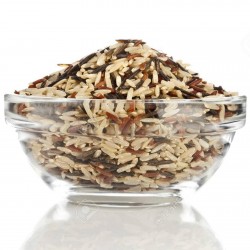
Rice Seeds (Mix Colors...
Pret
1,95 €
(SKU: VE 102 IR (3,6g))
Seeds Gallery EU,
5/
5
<!DOCTYPE html>
<html>
<head>
<meta http-equiv="Content-Type" content="text/html; charset=UTF-8" />
</head>
<body>
<h2><strong>Rice Seeds (Mix Colors Integral)</strong></h2>
<h2><span style="color: #ff0000;"><strong>Price for Package of 100 (3,6 g) seeds.</strong></span></h2>
<p>This pack contains several varieties of different color integral rice (see picture).</p>
<p>Integral rice is a whole grain and a good source of magnesium, phosphorus, selenium, thiamine, niacin, vitamin B6, and manganese, and is high in fiber. White rice, unlike brown rice, has the bran and germ removed, and therefore has different nutritional content.</p>
<p>It has been found that germinated grains, in general, have nutritional advantages. Germinated brown rice (GBR), developed during the International Year of Rice, is brown rice that has been soaked for 4–20 hours in warm 40 °C (104 °F) water before cooking. This stimulates germination, which activates various enzymes in the rice, giving rise to a more complete amino acid profile, including GABA. Cooked brown rice tends to be chewy; cooked GBR is softer, and preferred particularly by children.</p>
<p>Integral rice generally needs longer cooking times than white rice, unless it is broken. Studies by Gujral and Kumar in 2003 estimated a cooking time between 35 and 51 minutes.</p>
</body>
</html>
VE 102 IR (3,6g)


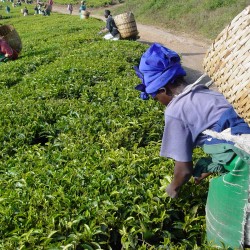
Tea Tree Seeds, tea plant,...
Pret
6,95 €
(SKU: MHS 3)
Seeds Gallery EU,
5/
5
<!DOCTYPE html>
<html>
<head>
<meta http-equiv="Content-Type" content="text/html; charset=UTF-8" />
</head>
<body>
<h2><strong>Tea Tree Seeds, tea plant, tea shrub (Camellia sinensis)</strong></h2>
<h2><span style="color: #ff0000;"><strong>Price for Package of 3 seeds.</strong></span></h2>
<p><i><b>Camellia sinensis</b></i><span> </span>is a<span> </span>species<span> </span>of evergreen<span> </span>shrubs<span> </span>or small<span> </span>trees<span> </span>in the<span> </span>flowering plant<span> </span>family<span> </span>Theaceae<span> </span>whose leaves and leaf buds are used to produce<span> </span>tea. Common names include "<b>tea plant</b>", "tea shrub", and "tea tree" (not to be confused with<span> </span><i>Melaleuca alternifolia</i>, the source of<span> </span>tea tree oil, or<span> </span><i>Leptospermum scoparium</i>, the New Zealand tea tree).</p>
<p><i>C. sinensis</i><span> </span>var.<span> </span><i>sinensis</i><span> </span>and<span> </span><i>C. s.</i><span> </span>var.<span> </span><i>assamica</i><span> </span>are two major varieties grown today.<sup id="cite_ref-2" class="reference">[2]</sup><span> </span>White tea,<span> </span>yellow tea,<span> </span>green tea,<span> </span>oolong,<span> </span>dark tea<span> </span>(which includes<span> </span>pu-erh tea) and<span> </span>black tea<span> </span>are all harvested from one or the other, but are<span> </span>processed<span> </span>differently to attain varying levels of<span> </span>oxidation.<span> </span>Kukicha<span> </span>(twig<span> </span>tea) is also harvested from<span> </span><i>C. sinensis</i>, but uses twigs and stems rather than leaves.</p>
<h2><span class="mw-headline" id="Nomenclature_and_taxonomy">Nomenclature and taxonomy</span></h2>
<p>The<span> </span>generic<span> </span>name<span> </span><i>Camellia</i><span> </span>is taken from the<span> </span>Latinized name<span> </span>of Rev.<span> </span>Georg Kamel,<sup id="cite_ref-3" class="reference">[3]</sup><span> </span>SJ<span> </span>(1661–1706), a<span> </span>Moravian-born<span> </span>Jesuit<span> </span>lay brother, pharmacist, and missionary to the<span> </span>Philippines.</p>
<p>Carl Linnaeus<span> </span>chose his name in 1753 for the genus to honor Kamel's contributions to botany<sup id="cite_ref-4" class="reference">[4]</sup><span> </span>(although Kamel did not discover or name this plant, or any<span> </span><i>Camellia</i>,<sup id="cite_ref-5" class="reference">[5]</sup><span> </span>and Linnaeus did not consider this plant a<span> </span><i>Camellia</i><span> </span>but a<span> </span><i>Thea</i>).<sup id="cite_ref-6" class="reference">[6]</sup></p>
<p>Robert Sweet<span> </span>shifted all formerly<span> </span><i>Thea</i><span> </span>species to the genus<span> </span><i>Camellia</i><span> </span>in 1818.<sup id="cite_ref-7" class="reference">[7]</sup><span> </span>The name<span> </span><i>sinensis</i><span> </span>means "from China" in<span> </span>Latin.</p>
<p>Four varieties of<span> </span><i>C. sinensis</i><span> </span>are recognized.<sup id="cite_ref-FOC_1-1" class="reference">[1]</sup><span> </span>Of these,<span> </span><i>C. sinensis</i><span> </span>var.<span> </span><i>sinensis</i><span> </span>and<span> </span><i>C. s.</i><span> </span>var.<span> </span><i>assamica</i><span> </span>(JW Masters) Kitamura are most commonly used for tea, and<span> </span><i>C. s.</i><span> </span>var.<span> </span><i>pubilimba</i><span> </span>Hung T. Chang and<span> </span><i>C. s.</i><span> </span>var.<span> </span><i>dehungensis</i><span> </span>(Hung T. Chang & BH Chen) TL Ming are sometimes used locally.<sup id="cite_ref-FOC_1-2" class="reference">[1]</sup><span> </span>The Cambod type tea (<i>C. assamica</i><span> </span>subsp.<span> </span><i>lasiocaly</i>) was originally considered a type of assam tea. However, later genetic work showed that it is a hybrid between Chinese small leaf tea and assam type tea.<sup id="cite_ref-8" class="reference">[8]</sup></p>
<p>Tea plants are native to East Asia, and probably originated in the borderlands of north Burma and southwestern China.<sup id="cite_ref-Yamamoto_9-0" class="reference">[9]</sup></p>
<ul>
<li>Chinese (small leaf) tea [<i>C. sinensis</i><span> </span>var.<span> </span><i>sinensis</i>]</li>
<li>Chinese Western Yunnan Assam (large leaf) tea [<i>C. sinensis</i><span> </span>var.<span> </span><i>assamica</i>]
<ul>
<li>Indian Assam (large leaf) tea [<i>C. sinensis</i><span> </span>var.<span> </span><i>assamica</i>]</li>
</ul>
</li>
<li>Chinese Southern Yunnan Assam (large leaf) tea [<i>C. sinensis</i><span> </span>var.<span> </span><i>assamica</i>]</li>
</ul>
<p>Chinese (small leaf) type tea may have originated in southern China possibly with hybridization of unknown wild tea relatives. However, since no wild populations of this tea are known, the precise location of its origin is speculative.<sup id="cite_ref-Meegahakumbura_1_10-0" class="reference">[10]</sup><sup id="cite_ref-Meegahakumbura_2_11-0" class="reference">[11]</sup></p>
<p>Given their genetic differences forming distinct<span> </span>clades, Chinese Assam type tea (<i>C. s.</i><span> </span>var.<span> </span><i>assamica</i>) may have two different parentages – one being found in southern<span> </span>Yunnan<span> </span>(Xishuangbanna,<span> </span>Pu'er City) and the other in western Yunnan (Lincang,<span> </span>Baoshan). Many types of Southern Yunnan Assam tea have been hybridized with the closely related species<span> </span><i>Camellia taliensis.</i><span> </span>Unlike Southern Yunnan Assam tea, Western Yunnan Assam tea shares many genetic similarities with Indian Assam type tea (also<span> </span><i>C. s.</i><span> </span>var.<span> </span><i>assamica</i>). Thus, Western Yunnan Assam tea and Indian Assam tea both may have originated from the same parent plant in the area where southwestern China, Indo-Burma, and Tibet meet. However, as the Indian Assam tea shares no<span> </span>haplotypes<span> </span>with Western Yunnan Assam tea, Indian Assam tea is likely to have originated from an independent domestication. Some Indian Assam tea appears to have hybridized with the species<span> </span><i>Camellia pubicosta.</i><sup id="cite_ref-Meegahakumbura_1_10-1" class="reference">[10]</sup><sup id="cite_ref-Meegahakumbura_2_11-1" class="reference">[11]</sup></p>
<p>Assuming a generation of 12 years, Chinese small leaf tea is estimated to have diverged from Assam tea around 22,000 years ago, while Chinese Assam tea and Indian Assam tea diverged 2,800 years ago. This divergence tea would correspond to the last<span> </span>glacial maximum.<sup id="cite_ref-Meegahakumbura_1_10-2" class="reference">[10]</sup><sup id="cite_ref-Meegahakumbura_2_11-2" class="reference">[11]</sup></p>
<p>Chinese small leaf type tea was introduced into India in 1836 by the British and some Indian Assam type tea (e.g.<span> </span>Darjeeling tea) appear to be genetic hybrids of Chinese small leaf type tea, native Indian Assam, and possibly also closely related wild tea species.<sup id="cite_ref-12" class="reference">[12]</sup></p>
<h2><span class="mw-headline" id="Cultivars">Cultivars</span></h2>
<p>Hundreds,<sup id="cite_ref-13" class="reference">[13]</sup><span> </span>if not thousands of<span> </span>cultivars<span> </span>of<span> </span><i>C. sinensis</i><span> </span>are known. Some Japanese cultivars include:</p>
<ul>
<li>Benifuuki<sup id="cite_ref-ijtc_14-0" class="reference">[14]</sup></li>
<li>Fushun<sup id="cite_ref-vdat_15-0" class="reference">[15]</sup></li>
<li>Kanayamidori<sup id="cite_ref-ijtc_14-1" class="reference">[14]</sup></li>
<li>Meiryoku<sup id="cite_ref-vdat_15-1" class="reference">[15]</sup></li>
<li>Saemidori<sup id="cite_ref-vdat_15-2" class="reference">[15]</sup></li>
<li>Okumidori<sup id="cite_ref-vdat_15-3" class="reference">[15]</sup></li>
<li>Yabukita<sup id="cite_ref-vdat_15-4" class="reference">[15]</sup></li>
</ul>
<h2><span class="mw-headline" id="Description">Description</span></h2>
<p><i>C. sinensis</i><span> </span>is native to<span> </span>East Asia, the<span> </span>Indian Subcontinent, and<span> </span>Southeast Asia, but it is today cultivated across the world in tropical and subtropical regions. It is an evergreen<span> </span>shrub<span> </span>or small<span> </span>tree<span> </span>that is usually trimmed to below 2 m (6.6 ft) when cultivated for its leaves. It has a strong<span> </span>taproot. The flowers are yellow-white, 2.5–4 cm (0.98–1.57 in) in diameter, with seven or eight petals.</p>
<div class="thumb tright">
<div class="thumbinner"><img alt="Tea Tree Seeds, tea plant, tea shrub (Camellia sinensis)" src="https://upload.wikimedia.org/wikipedia/commons/thumb/3/36/Flower_of_Tea_plant.jpg/220px-Flower_of_Tea_plant.jpg" width="220" height="147" class="thumbimage" title="Tea Tree Seeds, tea plant, tea shrub (Camellia sinensis)" />
<div class="thumbcaption">
<div class="magnify"></div>
Flower of tea plant</div>
</div>
</div>
<p>The seeds of<span> </span><i>C. sinensis</i><span> </span>and<span> </span><i>C. oleifera</i><span> </span>can be pressed to yield<span> </span>tea oil, a sweetish seasoning and cooking oil that should not be confused with<span> </span>tea tree oil, an<span> </span>essential oil<span> </span>that is used for medical and cosmetic purposes, and originates from the leaves of a different plant.</p>
<div class="thumb tright">
<div class="thumbinner"><img alt="Tea Tree Seeds, tea plant, tea shrub (Camellia sinensis)" src="https://upload.wikimedia.org/wikipedia/commons/thumb/e/e3/Camellia_sinensis_-_K%C3%B6hler%E2%80%93s_Medizinal-Pflanzen-025.jpg/220px-Camellia_sinensis_-_K%C3%B6hler%E2%80%93s_Medizinal-Pflanzen-025.jpg" width="220" height="267" class="thumbimage" title="Tea Tree Seeds, tea plant, tea shrub (Camellia sinensis)" />
<div class="thumbcaption">
<div class="magnify"></div>
<i>C. sinensis</i><span> </span>plant, with cross-section of the flower (lower left) and seeds (lower right)</div>
</div>
</div>
<div class="thumb tright">
<div class="thumbinner"><img alt="Tea Tree Seeds, tea plant, tea shrub (Camellia sinensis)" src="https://upload.wikimedia.org/wikipedia/commons/thumb/e/e3/Camellia_sinensis_MHNT.BOT.2016.12.24.jpg/220px-Camellia_sinensis_MHNT.BOT.2016.12.24.jpg" width="220" height="166" class="thumbimage" title="Tea Tree Seeds, tea plant, tea shrub (Camellia sinensis)" />
<div class="thumbcaption">
<div class="magnify"></div>
<i>C. sinensis</i><span> </span>-<span> </span>MHNT</div>
</div>
</div>
<p>The leaves are 4–15 cm (1.6–5.9 in) long and 2–5 cm (0.79–1.97 in) broad. Fresh leaves contain about 4%<span> </span>caffeine, as well as related compounds including<span> </span>theobromine.<sup id="cite_ref-16" class="reference">[16]</sup><span> </span>The young, light-green leaves are preferably harvested for tea production; they have short, white hairs on the underside. Older leaves are deeper green. Different leaf ages produce differing tea qualities, since their chemical compositions are different. Usually, the tip (bud) and the first two to three leaves are harvested for processing. This hand picking is repeated every one to two weeks.</p>
<p>In 2017, Chinese scientists sequenced the genome of<span> </span><i>C. s. var. assamica .</i><span> </span>It contains about three billion base pairs, which was larger than most plants previously sequenced.</p>
<h2><span class="mw-headline" id="Cultivation">Cultivation</span></h2>
<p><i>C. sinensis</i><span> </span>is mainly cultivated in tropical and subtropical climates, in areas with at least 127 cm (50 in) of rainfall a year. Tea plants prefer a rich and moist growing location in full to part sun and can be grown in<span> </span>hardiness zones<span> </span>7 – 9. However, the clonal one is commercially cultivated from the equator to as far north as<span> </span>Cornwall<span> </span>and<span> </span>Scotland<span> </span>on the UK mainland.<sup id="cite_ref-19" class="reference">[19]</sup><sup id="cite_ref-20" class="reference">[20]</sup><span> </span>Many high-quality teas are grown at high elevations, up to 1,500 m (4,900 ft), as the plants grow more slowly and acquire more flavor.</p>
<p>Tea plants will grow into a tree if left undisturbed, but cultivated plants are pruned to waist height for ease of plucking. Two principal varieties are used, the small-leaved Chinese variety plant (<i>C. s. sinensis</i>) and the large-leaved Assamese plant (<i>C. s. assamica</i>), used mainly for black tea.</p>
<h3><span class="mw-headline" id="Chinese_teas">Chinese teas</span></h3>
<p>The Chinese plant is a small-leafed bush with multiple stems that reaches a height of some 3 m. It is native to southeast China. The first tea plant variety to be discovered, recorded, and used to produce tea dates back 3,000 years ago, it yields some of the most popular teas.</p>
<p><i>C. s.</i><span> </span>var.<span> </span><i>waldenae</i><span> </span>was considered a different species,<span> </span><i>C. waldenae</i><span> </span>by SY Hu,<sup id="cite_ref-ICS_21-0" class="reference">[21]</sup><span> </span>but it was later identified as a variety of<span> </span><i>C. sinensis</i>.<sup id="cite_ref-22" class="reference">[22]</sup><span> </span>This variety is commonly called Waldenae Camellia. It is seen on<span> </span>Sunset Peak<span> </span>and<span> </span>Tai Mo Shan<span> </span>in<span> </span>Hong Kong. It is also distributed in<span> </span>Guangxi<span> </span>province, China.<sup id="cite_ref-ICS_21-1" class="reference">[21]</sup></p>
<h3><span class="mw-headline" id="Indian_and_Nepali_teas">Indian and Nepali teas</span></h3>
<p>Three main kinds of tea are produced in India:</p>
<ul>
<li>Assam<span> </span>comes from the heavily forested northeastern section of the country,<span> </span>Assam. Tea from here is rich and full-bodied. In Assam, the first tea estate of India was established, in 1837.</li>
<li>Darjeeling<span> </span>is from the cool and wet<span> </span>Darjeeling<span> </span>region, tucked in the foothills of the<span> </span>Himalayas. Tea plantations reach 2,200 meters. The tea is delicately flavored and considered to be one of the finest teas in the world. The Darjeeling plantations have three distinct harvests, termed 'flushes', and the tea produced from each flush has a unique flavor. First (spring) flush teas are light and aromatic, while the second (summer) flush produces tea with a bit more bite. The third, or autumn flush gives a tea that is lesser in quality.</li>
</ul>
<p>Nepali tea is also considered to be similar to the tea produced in Darjeeling, mostly because the eastern part of Nepal, where a large amount of tea is produced, has similar topography to that of Darjeeling.</p>
<ul>
<li>Nilgiri<span> </span>is from a southern region of India almost as high as Darjeeling. Grown at elevations between 1,000 and 2,500 m, Nilgiri teas are subtle and rather gentle and are frequently blended with other, more robust teas.<sup class="noprint Inline-Template Template-Fact">[<i><span title="This claim needs references to reliable sources. (December 2014)">citation needed</span></i>]</sup></li>
</ul>
<div class="thumb tright">
<div class="thumbinner"><img alt="Tea Tree Seeds, tea plant, tea shrub (Camellia sinensis)" src="https://upload.wikimedia.org/wikipedia/commons/thumb/8/84/Camellia_sinensis-fruto.jpg/200px-Camellia_sinensis-fruto.jpg" width="200" height="150" class="thumbimage" title="Tea Tree Seeds, tea plant, tea shrub (Camellia sinensis)" />
<div class="thumbcaption">
<div class="magnify"></div>
Seed-bearing fruit of<span> </span><i>C. sinensis</i></div>
</div>
</div>
<h3><span class="mw-headline" id="Pests_and_diseases">Pests and diseases</span></h3>
<div class="hatnote navigation-not-searchable">Main article:<span> </span>List of tea diseases</div>
<div class="hatnote navigation-not-searchable">See also:<span> </span>List of Lepidoptera that feed on Camellia</div>
<p>Tea leaves are eaten by some<span> </span>herbivores, such as the<span> </span>caterpillars<span> </span>of the<span> </span>willow beauty<span> </span>(<i>Peribatodes rhomboidaria</i>), a<span> </span>geometer moth.</p>
<h2><span class="mw-headline" id="Health_effects">Health effects</span></h2>
<p>Although health benefits have been assumed throughout the history of using tea as a common beverage, no high-quality evidence shows that tea confers significant benefits.<sup id="cite_ref-medline_23-0" class="reference">[23]</sup><sup id="cite_ref-nccih_24-0" class="reference">[24]</sup><span> </span>In<span> </span>clinical research<span> </span>over the early 21st century, tea has been studied extensively for its potential to lower the risk of<span> </span>human diseases, but none of this research is conclusive as of 2017.</p>
<h2><span class="mw-headline" id="Biosynthesis_of_caffeine">Biosynthesis of caffeine</span></h2>
<p>Caffeine, a molecule produced in<span> </span><i>C. sinensis</i>, functions as a<span> </span>secondary metabolite. Caffeine is a purine alkaloid and its biosynthesis occurs in young tea leaves and is regulated by several enzymes.<sup id="cite_ref-25" class="reference">[25]</sup><sup id="cite_ref-26" class="reference">[26]</sup><span> </span>The biosynthetic pathway in<span> </span><i>C. sinensis</i><span> </span>differs from other caffeine-producing plants such as<span> </span>coffee<span> </span>or<span> </span>guayusa. Analysis of the pathway was carried out by harvesting young leaves and using reverse transcription<span> </span>PCR<span> </span>to analyze the genes encoding the major enzymes involved in synthesizing caffeine. The gene<span> </span><i>TCS1</i><span> </span>encodes caffeine synthase. Younger leaves feature high concentrations of TCS1 transcripts, allowing more caffeine to be synthesized during this time. Dephosphorylation of xanthosine-5'-monophosphate into<span> </span>xanthosine<span> </span>is the committed step for the xanthosines entering the beginning of the most common pathway. A sequence of reactions turns xanthosine into 7-methylxanthosine, then 7-methylxanthine, then theobromine, and finally into caffeine.</p>
<h2 class="title style-scope ytd-video-primary-info-renderer"><yt-formatted-string force-default-style="" class="style-scope ytd-video-primary-info-renderer">Tea Germination from Seed</yt-formatted-string></h2>
<p><iframe width="640" height="385" src="https://www.youtube.com/embed/Dh9dhkOBynw?rel=0&hd=1" frameborder="0" allowfullscreen="allowfullscreen" class="embed-responsive-item"> </iframe></p>
</body>
</html>
MHS 3


Varietate din Serbia
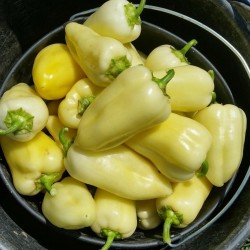
Matica Sweet Pepper Seeds
Pret
1,85 €
(SKU: PP 69)
Seeds Gallery EU,
5/
5
<h2 class=""><strong>Matica Sweet Pepper Seeds</strong></h2>
<h2><span style="color: #ff0000;"><strong>Price for Package of 60 (0.4g) seeds.</strong></span></h2>
<p>Matica sweet pepper is one of the favorite medium late Serbian varieties in Serbia. The fruit has a Conical shape with a single tip, reminiscent of the old native variety Somborka, but is sweet pepper. The weight of the fruit is 70-100 g and the thickness of the pericarp 5-6 mm. </p>
<p>In technological maturity, the fruit is light green to yellow, and in physiological intense red. A favorite variety for baked peppers, because it is easy to separate the skin from the meat of the fruit and is, therefore, a favorite with housewives in Serbia.</p>
<script src="//cdn.public.n1ed.com/G3OMDFLT/widgets.js"></script>
PP 69 (60 S)


Varietate din Serbia
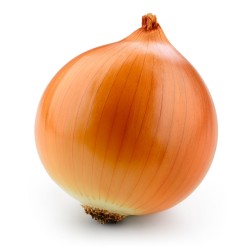
Onion Seeds Kupusinski Jabucar
Pret
1,70 €
(SKU: MHS 150)
Seeds Gallery EU,
5/
5
<meta http-equiv="Content-Type" content="text/html; charset=UTF-8" />
<h2><strong>Onion Seeds Kupusinski Jabucar</strong></h2>
<h2><span style="color: #ff0000;"><strong>Price for Package of 100 seeds.</strong></span></h2>
<p>Kupusinski jabučar is old Serbian variety, and one of the favorite old varieties The fruit bulb is apple-shaped (hence the name Kupusinski jabučar), with a solid, well-closed neck. Sheath leaves are dark yellow in color. This variety can be stored for a long time, without to lose taste.</p>
<p>"Kupusinski jabučar" translated to English "Apple Onion aus Kupusina" (Kupusina is Village in Serbia).</p>
<p>The medium-hot variety is grown successfully from seeds. The average mass of the fruit bulb is 80-120 g. </p>
<p>The dry matter content is 12-14%. It yields about 300 mc/ha.</p>
<p>
<script type="text/javascript"></script>
</p>
MHS 150 (100 S)


Varietate din Serbia
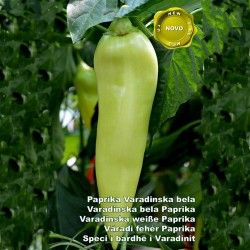
Varadinska White pepper seeds
Pret
1,65 €
(SKU: P 47)
Seeds Gallery EU,
5/
5
<h2><strong>Varadinska White pepper seeds</strong></h2>
<h2><span style="color: #ff0000;"><strong>Price for Package of 20 seeds.</strong></span></h2>
<p>Varadinska White pepper is a variety from Serbia. An early variety of pepper (from sprouting to technological maturity 118-120 days to biological 135-140 days), with long and large fruits. Excellent sweet taste, juicy, and crispy. Perfect for fresh consumption, barbeque, cooking, pickling. One of the favorite varieties in Serbia for making <span style="color: #0000ff;"><a href="https://www.google.com/search?q=lu%C4%8Dene+paprike&oq=lu%C4%8Dene+paprike&aqs=chrome..69i57j69i60&sourceid=chrome&ie=UTF-8" target="_blank" title=""lučene paprike"" style="color: #0000ff;" rel="noreferrer noopener"><strong>"lučene paprike"</strong></a></span></p>
<p>At full technological maturity, the fruits are milky white in color, while in biological ones they are intensely red. The plant forms hanging fruits 20-24cm long, 5-6 cm wide, 4-5mm thick meat-pericarp with an average weight of 120-130 grams.</p>
<p>It is suitable for year-round production in a protected area and achieves an extremely high yield potential in the open field (40-45 t / ha), with the application of appropriate agro-technical measures.</p>
P 47 (20 S)

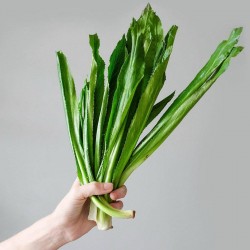
Mexican Coriander Seeds...
Pret
1,95 €
(SKU: MHS 32)
Seeds Gallery EU,
5/
5
<meta http-equiv="Content-Type" content="text/html; charset=UTF-8" />
<h2><strong>Mexican Coriander Seeds (Eryngium foetidum)</strong></h2>
<h2><span style="color: #ff0000;"><strong>Price for a Package of 20 seeds.</strong></span></h2>
<p>Eryngium foetidum is a tropical perennial herb in the family Apiaceae. Common names include culantro , recao, shadow beni, Mexican coriander, bhandhania, long coriander, sawtooth coriander, and ngò gai. It is native to Mexico, the Caribbean, Central and South America, but is cultivated worldwide, sometimes being grown as an annual in temperate climates.</p>
<p>In the United States, the common name culantro sometimes causes confusion with cilantro, a common name for the leaves of Coriandrum sativum (also in Apiaceae), of which culantro is said to taste like a stronger version.</p>
<p><strong>Uses</strong></p>
<p><strong>Culinary</strong></p>
<ol>
<li>foetidum is widely used in seasoning, marinating and garnishing in the Caribbean, particularly in Cuba, Dominican Republic, Puerto Rico, Trinidad and Tobago, Panama, Guyana, Suriname, and in Ecuador and Peru's Amazon regions. It is used extensively in Cambodia, Thailand, India, Vietnam, Laos,Myanmar and other parts of Asia as a culinary herb.[5] It dries well, retaining good color and flavor, making it valuable in the dried herb industry. It is sometimes used as a substitute for coriander, but it has a much stronger taste.</li>
</ol>
<p> </p>
<p>In the United States, E. foetidum grows naturally in Florida, Georgia, Hawaii, Puerto Rico, and the Virgin Islands.</p>
<p><strong>Traditional medicine</strong></p>
<ol>
<li>foetidum has been used in traditional medicine in tropical regions for burns, earache, fevers, hypertension, constipation, fits, asthma, stomachache, worms, infertility complications, snake bites, diarrhea, and malaria.</li>
<li>foetidum is also known as E. antihystericum.[8] The specific name antihystericum reflects the fact that this plant has traditionally been used for epilepsy.[9] The plant is said to calm a person's 'spirit' and thus prevents epileptic 'fits', so is known by the common names spiritweed and fitweed. The anticonvulsant properties of this plant have been scientifically investigated.[10][medical citation needed] A decoction of the leaves has been shown to exhibit anti-inflammatory and analgesic effects in rats.</li>
</ol>
<p>Eryngial is a chemical compound isolated from E. foetidum.[12] The University of the West Indies at Mona, Jamaica, has investigated the use of enyngial as a treatment for human Strongyloides stercoralis infection (strongyloidiasis).</p>
<p>It is used as an ethnomedicinal plant for the treatment of a number of ailments such as fevers, chills, vomiting, burns, fevers, hypertension, headache, earache, stomachache, asthma, arthritis, snake bites, scorpion stings, diarrhea, malaria and epilepsy.[medical citation needed] The main constituent of essential oil of the plant is eryngial (E-2-dodecenal). A pharmacological investigation claims to have demonstrated anthelmintic, anti-inflammatory, analgesic, anticonvulsant, anticlastogenic, anticarcinogenic, antidiabetic, and antibacterial activity.</p>
<p> </p>
MHS 32 (20 S)


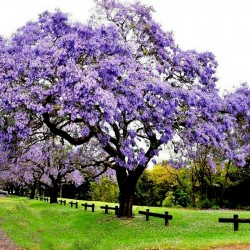
500 Seeds Paulownia Tomentosa
Pret
9,00 €
(SKU: T 14 T)
Seeds Gallery EU,
5/
5
<!DOCTYPE html>
<html>
<head>
<meta http-equiv="Content-Type" content="text/html; charset=UTF-8" />
</head>
<body>
<h2><strong>500 Seeds Paulownia Tomentosa (Empress, Foxglove Tree)</strong></h2>
<h2><span style="color: #ff0000;"><strong>Price for Package of 500 seeds.</strong></span></h2>
<div>
<div>Paulownia tormentosa is known by many names; regardless of what you want to call it, there is no doubt about its impressive ornamental features. This beautiful tree puts on an awe inspiring show in spring. Its soft chamois velvet buds open into large violet to blue, trumpet-like blossoms which fill the air with a sweet fragrance. The flowers carried on long up curved shoots, look like large foxgloves.</div>
<div>The huge leaves are an architectural delight: the soft, downy, large leaves appear after the flowers have opened.</div>
<div>Native to eastern Asia, this exotic looking, deciduous tree is surprisingly hardy and can tolerate harsh winters, to - 8*C (-14*F). Hardy throughout the British Isles, the buds of the Foxglove-like flowers are formed in the autumn and can be damaged by late frosts. They must be sheltered from hard frosts to ensure the violet blooms appear in spring.</div>
<div>It is a fast growing tree, usually grown as a specimen or shade tree. Growing rapidly (to 6f)t in it first year. In 3-5 years, this tree achieves what many other tree species take generations to achieve. An excellent use of this plant is the production of "stooled" specimens giving perhaps the most magnificent of all foliage dot plants. All growth is cut down to ground level each March and the resultant suckers reduced to a single shoot. The result is a strong, erect growth rising to 10 ft. and bearing huge and handsome leaves, producing a most striking effect. In very cold zones they are often grown and cut to near ground level in autumn and grown as a large-leafed shrub the following season.</div>
<div>Very easy to germinate, seedlings grow rapidly, flowering in as little as 2-3 years under good growing conditions.</div>
<div>It has been awarded the prestigious RHS Award of Garden Merit.</div>
<div>Named after the Princess of the Dutch region, Anna Paulowna, who died in 1865. It has never been found in the wild although it undoubtedly originated in China where an old custom is to plant an Empress Tree when a baby girl is born. The fast-growing tree matures as she does. When she is eligible for marriage the tree is cut down and carved into wooden articles for her dowry. Carving the wood of Paulownia is an art form in Japan and China.</div>
<div>Sowing: </div>
<div>Sow September to May</div>
<div>The seeds are very small so sow as thinly as possible to avoid crowding which leave seedlings more susceptible to damping off. Place the seeds on the surface of a tray containing well drained compost. Do not cover the seeds as light is required for germination.</div>
<div>Stand the tray in water to soak and either cover with a plastic dome or place the tray into a plastic bag. Temperatures should ideally not exceed 30*C (85*F) during the daytime and not below 18*C (60*F) at night. Always keep the soil mixture moist (not soaked) during the germination process. The seeds will germinate in 30 – 60 days and grow rapidly when conditions are favourable.</div>
<div>Growing: </div>
<div>After germination, remove the cover or bag. When seedlings are big enough to handle (about 2-3 weeks), carefully transfer to pots. Grow on until they are strong enough to plant into their permanent positions. Harden off before planting out (after the last expected frosts).</div>
<div>Aftercare: </div>
<div>Pruning should be done in autumn after leaf drop. prune down to where an axillary bud can take over as the single leader. Coppicing a tree annually sacrifices the flowers but produces 3m (10ft) stems with enormous leaves up to 60cm (2ft) across.</div>
<div>Plant Uses: </div>
<div>A specimen tree, shade tree, or focal point.</div>
<span style="font-size: 11px; line-height: 1.5em;">Fully hardy to -25°C.</span></div>
<div>
<table cellspacing="0" cellpadding="0" border="1">
<tbody>
<tr>
<td colspan="2" width="100%" valign="top">
<p><span style="color: #008000;"><strong>Sowing Instructions</strong></span></p>
</td>
</tr>
<tr>
<td valign="top" nowrap="nowrap">
<p><span style="color: #008000;"><strong>Propagation:</strong></span></p>
</td>
<td valign="top">
<p><span style="color: #008000;">Seeds</span></p>
</td>
</tr>
<tr>
<td valign="top" nowrap="nowrap">
<p><span style="color: #008000;"><strong>Pretreat:</strong></span></p>
</td>
<td valign="top">
<p><span style="color: #008000;">0</span></p>
</td>
</tr>
<tr>
<td valign="top" nowrap="nowrap">
<p><span style="color: #008000;"><strong>Stratification:</strong></span></p>
</td>
<td valign="top">
<p><span style="color: #008000;">0</span></p>
</td>
</tr>
<tr>
<td valign="top" nowrap="nowrap">
<p><span style="color: #008000;"><strong>Sowing Time:</strong></span></p>
</td>
<td valign="top">
<p><span style="color: #008000;">all year round </span></p>
</td>
</tr>
<tr>
<td valign="top" nowrap="nowrap">
<p><span style="color: #008000;"><strong>Sowing Depth:</strong></span></p>
</td>
<td valign="top">
<p><span style="color: #008000;">Light germinator! Only sprinkle on the surface of the substrate + slightly press on</span></p>
</td>
</tr>
<tr>
<td valign="top" nowrap="nowrap">
<p><span style="color: #008000;"><strong>Sowing Mix:</strong></span></p>
</td>
<td valign="top">
<p><span style="color: #008000;">Coir or sowing mix + sand or perlite</span></p>
</td>
</tr>
<tr>
<td valign="top" nowrap="nowrap">
<p><span style="color: #008000;"><strong>Germination temperature:</strong></span></p>
</td>
<td valign="top">
<p><span style="color: #008000;">22-25°C</span></p>
</td>
</tr>
<tr>
<td valign="top" nowrap="nowrap">
<p><span style="color: #008000;"><strong>Location:</strong></span></p>
</td>
<td valign="top">
<p><span style="color: #008000;">bright + keep constantly moist not wet</span></p>
</td>
</tr>
<tr>
<td valign="top" nowrap="nowrap">
<p><span style="color: #008000;"><strong>Germination Time:</strong></span></p>
</td>
<td valign="top">
<p><span style="color: #008000;">4-6 weeks</span></p>
</td>
</tr>
<tr>
<td valign="top" nowrap="nowrap">
<p><span style="color: #008000;"><strong>Watering:</strong></span></p>
</td>
<td valign="top">
<p><span style="color: #008000;">Water regularly during the growing season</span></p>
</td>
</tr>
<tr>
<td valign="top" nowrap="nowrap">
<p><span style="color: #008000;"><strong> </strong></span></p>
</td>
<td valign="top">
<p><br /><span style="color: #008000;"><em>Copyright © 2012 Seeds Gallery - Saatgut Galerie - Galerija semena. </em><em>All Rights Reserved.</em><em></em></span></p>
</td>
</tr>
</tbody>
</table>
</div>
</body>
</html>
T 14 T

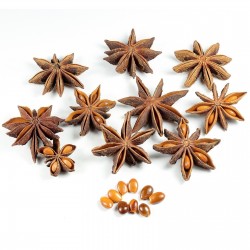
Star Anise Seeds (Illicium...
Pret
3,50 €
(SKU: MHS 116)
Seeds Gallery EU,
5/
5
<h2 class=""><strong>Star Anise Seeds (Illicium verum)</strong></h2>
<h2><span style="color: #ff0000;"><strong>Price for Package of 3 seeds.</strong></span></h2>
<p><i><b>Illicium verum</b></i><span> </span>is a medium-sized<span> </span>evergreen<span> </span>tree native to northeast<span> </span>Vietnam<span> </span>and southwest China. A spice commonly called<span> </span><b>star anise</b>,<span> </span><b>staranise</b>,<span> </span><b>star anise seed</b>,<span> </span><b>Chinese star anise</b>, or<span> </span><b>badiane</b><span> </span>that closely resembles<span> </span>anise<span> </span>in flavor is obtained from the star-shaped<span> </span>pericarps<span> </span>of the fruit of<span> </span><i>I. verum</i><span> </span>which are harvested just before ripening. Star anise oil is a highly fragrant oil used in cooking, perfumery, soaps, toothpastes, mouthwashes, and skin creams. About 90% of the world's star anise crop is used for extraction of<span> </span>shikimic acid, a chemical intermediate used in the synthesis of<span> </span>oseltamivir<span> </span>(Tamiflu).</p>
<h2><span class="mw-headline" id="Nomenclature">Nomenclature</span></h2>
<table class="infobox">
<tbody>
<tr>
<td colspan="2">Star anise</td>
</tr>
<tr>
<th scope="row">Chinese</th>
<td><span lang="zh-hani" title="Chinese language text" xml:lang="zh-hani">八角</span></td>
</tr>
<tr>
<th scope="row">Literal meaning</th>
<td>"eight-horns"</td>
</tr>
<tr>
<td colspan="2">
<table class="collapsible collapsed mw-collapsible mw-collapsed mw-made-collapsible">
<tbody>
<tr>
<th colspan="2"><span class="mw-collapsible-toggle mw-collapsible-toggle-default mw-collapsible-toggle-collapsed">show</span>Transcriptions</th>
</tr>
</tbody>
</table>
</td>
</tr>
</tbody>
</table>
<p><i>Illicium</i><span> </span>comes from the Latin<span> </span><i>illicio</i><span> </span>meaning "entice". In<span> </span>Persian, star anise is called<span> </span><span lang="fa" title="Persian language text" xml:lang="fa">بادیان</span><span> </span><i>bādiyān</i>, hence its French name<span> </span><i><i>badiane</i></i>.</p>
<h2><span class="mw-headline" id="Use">Use</span></h2>
<h3><span class="mw-headline" id="Culinary_use">Culinary use</span></h3>
<div class="thumb tright">
<div class="thumbinner"><img alt="" src="https://upload.wikimedia.org/wikipedia/commons/thumb/a/aa/Star_Aniseed_back.jpg/220px-Star_Aniseed_back.jpg" width="220" height="190" class="thumbimage" />
<div class="thumbcaption">
<div class="magnify"></div>
Reverse side of fruit</div>
</div>
</div>
<div class="thumb tright">
<div class="thumbinner"><img alt="" src="https://upload.wikimedia.org/wikipedia/commons/thumb/f/f2/Illicium_verum00.jpg/220px-Illicium_verum00.jpg" width="220" height="396" class="thumbimage" />
<div class="thumbcaption">
<div class="magnify"></div>
Plate from<span> </span>François-Pierre Chaumeton's 1833<span> </span><i>Flore Medicale</i></div>
</div>
</div>
<p>Star anise contains<span> </span>anethole, the same compound that gives the unrelated<span> </span>anise<span> </span>its flavor. Recently, star anise has come into use in the<span> </span>West<span> </span>as a less expensive substitute for anise in baking, as well as in<span> </span>liquor<span> </span>production, most distinctively in the production of the<span> </span>liqueur<span> </span>Galliano.<sup id="cite_ref-2" class="reference">[2]</sup><span> </span>Star anise enhances the flavour of meat.</p>
<p>It is used as a spice in preparation of<span> </span><i>biryani</i><span> </span>and<span> </span><i>masala chai</i><span> </span>all over the<span> </span>Indian subcontinent. It is widely used in<span> </span>Chinese cuisine, and in<span> </span>Malay<span> </span>and<span> </span>Indonesian cuisines. It is widely grown for commercial use in China, India, and most other countries in Asia. Star anise is an ingredient of the traditional<span> </span>five-spice powder<span> </span>of Chinese cooking. It is also a major ingredient in the making of<span> </span><i>phở</i>, a<span> </span>Vietnamese<span> </span>noodle soup.</p>
<p>It is also used in the French recipe of mulled wine, called<span> </span><i>vin chaud</i><span> </span>(hot wine). If allowed to steep in coffee, it deepens and enriches the flavor. The pods can be used in this manner multiple times by the pot-full or cup, as the ease of extraction of the taste components increases with the permeation of hot water.</p>
<h3><span class="mw-headline" id="Drug_precursor">Drug precursor</span></h3>
<div class="hatnote navigation-not-searchable">Main article:<span> </span>Oseltamivir total synthesis</div>
<p>Star anise is the major source of the chemical compound<span> </span>shikimic acid, a primary<span> </span>precursor<span> </span>in the<span> </span>pharmaceutical<span> </span>synthesis of the antiinfluenza<span> </span>drug,<span> </span>oseltamivir<span> </span>(Tamiflu).<sup id="cite_ref-Bilal_4-0" class="reference">[4]</sup><sup id="cite_ref-Drugs_5-0" class="reference">[5]</sup><sup id="cite_ref-Wang_6-0" class="reference">[6]</sup>An industrial method for the production of shikimic acid using<span> </span>fermentation<span> </span>of<span> </span><i>E. coli</i><span> </span>bacteria was discovered in 2005,<sup id="cite_ref-7" class="reference">[7]</sup><sup id="cite_ref-8" class="reference">[8]</sup><span> </span>and applied in the<span> </span>2009 swine flu outbreak<span> </span>to address Tamiflu shortages, also causing price increases for star anise as a<span> </span>raw material<span> </span>of shikimic acid.<sup id="cite_ref-lim_9-0" class="reference">[9]</sup><span> </span>As of 2018, fermentation of<span> </span><i>E. coli</i><span> </span>was the manufacturing process of choice to produce shikimic acid for synthesis of Tamiflu.<sup id="cite_ref-Drugs_5-1" class="reference"></sup></p>
<h2><span class="mw-headline" id="Toxicity">Toxicity</span></h2>
<p>Japanese star anise<span> </span>(<i>Illicium anisatum</i>), a similar tree, is highly toxic and inedible; in Japan, it has instead been burned as<span> </span>incense. Cases of illness, including "serious<span> </span>neurologicaleffects, such as seizures", reported after using star anise tea, may be a result of deliberate<span> </span>economically motivated adulteration<span> </span>with this species. Japanese star anise contains the<span> </span>neurotoxin<span> </span>anisatin,<sup id="cite_ref-PubChem_10-0" class="reference">[10]</sup><span> </span>which also causes severe<span> </span>inflammation<span> </span>of the<span> </span>kidneys<span> </span>(nephritis),<span> </span>urinary tract, and<span> </span>digestive organs<span> </span>when ingested.</p>
<p>Swamp star anise<span> </span><i>Illicium parviflorum</i><span> </span>is a similar tree found in the Southern United States, and due to its toxicity, it should not to be used for folk remedies or as a cooking ingredient.</p>
<h2><span class="mw-headline" id="Standardization_of_its_products_and_services">Standardization of its products and services</span></h2>
<ul>
<li>ISO 676:1995 - contains the information about the nomenclature of the variety and cultivars</li>
</ul>
<h3><span class="mw-headline" id="Identification">Identification</span></h3>
<ul>
<li>Refer to the 4th edition of the<span> </span><i>European Pharmacopoeia</i><span> </span>(1153)</li>
</ul>
<h3><span class="mw-headline" id="Differentiation_from_other_species">Differentiation from other species</span></h3>
<p>Joshi<span> </span><i>et al.</i><span> </span>have used<span> </span>fluorescent microscopy<span> </span>and<span> </span>gas chromatography<sup id="cite_ref-reiivh_14-0" class="reference">[14]</sup><span> </span>to distinguish the species, while Lederer<span> </span><i>et al.</i><span> </span>employed<span> </span>thin layer chromatography<span> </span>with<span> </span>HPLC-MS/MS</p>
<p><span style="color: inherit; font-family: inherit; font-size: 30px;">How to Grow Star Anise From Seeds</span></p>
<p>Star anise trees (<em>Illicium verum</em>) grow easily from seed. Star anise trees grow in U.S. Department of Agriculture plant hardiness zones 7 through 10 and do best with a soil pH between 4 and 6 that's rich in organic matter. They grow in either full sun or part shade.</p>
<p><span style="color: inherit; font-family: inherit; font-size: 30px;">Preparing and Planting Star Anise Seeds</span></p>
<p>Carefully preparing and planting the seeds will give the best chance of success. Or, store the seeds in moist sand in a sealed plastic bag or container in the refrigerator for up to a month.</p>
<p><span style="color: inherit; font-family: inherit; font-size: 30px;">Step 1</span></p>
<p>Pour seed-starting potting mix into 4- to 6-inch-diameter plastic pots. Fill them to 1 to 1 1/2 inches from the top. Moisten the mix with room-temperature water. Use pots that have drainage holes in them.</p>
<p><span style="color: inherit; font-family: inherit; font-size: 30px;">Step 2</span></p>
<p>Place the seeds into a bowl filled with water. Throw away any seeds that <strong>float</strong> to the surface. They are not viable. Plant only the seeds that sink to the bottom.</p>
<p><span style="color: inherit; font-family: inherit; font-size: 30px;">Step 3</span></p>
<p>Place two or three seeds per pot on top of the moistened potting mix, spaced evenly apart. Cover the seeds with a 1/4 to 1/2 inch of a moistened seed-starting mix. Firm it gently with your fingers to remove air pockets. Set plastic water or soda bottle with the bottom cut out over the seeds. Leave the screw caps on.</p>
<p><span style="color: inherit; font-family: inherit; font-size: 30px;">Step 4</span></p>
<p>Put the containers in bright, indirect light where temperatures stay around 70 degrees Fahrenheit. Moisten the potting mix using a spray bottle with room-temperature water if it begins to dry or set the containers in 1 to 2 inches of room-temperature water for an hour or two. The water will soak up into the germination mix through the holes in the bottoms of the containers.</p>
<p><span style="color: inherit; font-family: inherit; font-size: 30px;">Step 5</span></p>
<p>Remove the screw caps from the tops of the bottles after the seeds germinate. Remove the bottles a week later. The seeds should germinate in <strong>one to two months</strong>.</p>
<p><span style="color: inherit; font-family: inherit; font-size: 30px;">Step 6</span></p>
<p>Pot the star anise tree seedlings up in individual 6- to 8-inch pots when they are 3 to 4 inches tall. Use pots with drainage holes. Pot them up using <strong>peat-based</strong> potting soil. Set them in bright, indirect light and water them with room-temperature water when the top of the potting soil begins to dry.</p>
<p><span style="color: inherit; font-family: inherit; font-size: 30px;">Step 7</span></p>
<p>Grow the star anise plants in their containers for one year. Repot them into containers 1 inch larger when they become pot-bound or when you can see the roots through the drain holes in the bottom of the container. <strong>Set them outdoors</strong> during the day in the summer when there is no danger of frost and the weather is calm and pleasant. Put them in bright shade in an area that is protected from strong winds. Continue to water them when the top of the soil begins to dry.</p>
<p><span style="color: inherit; font-family: inherit; font-size: 30px;">Step 8</span></p>
<p>Plant them outdoors in their permanent positions the following spring after any danger of frost has passed. Begin to get them used to direct sunlight two weeks before planting. Start with an hour of direct morning sunlight and increase the duration by 30 minutes or so every two days. Water them when the top 2 inches of soil feel dry. Plant multiple trees 15 to 20 feet apart. Water them generously right after planting and continue to water them as often as necessary to keep the soil lightly moist.</p>
<script src="//cdn.public.n1ed.com/G3OMDFLT/widgets.js"></script>
MHS 116 (3 S)


Varietate din Croația
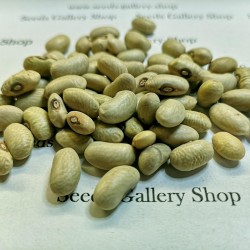
Green Beans Seeds SLAVONSKI...
Pret
1,35 €
(SKU: VE 44 (10g))
Seeds Gallery EU,
5/
5
<h2><strong>Green Beans Seeds “Slavonski Zeleni”</strong></h2>
<h2 class=""><span style="color: #ff0000;"><strong>Price for Package of 20 (10g) seeds.</strong></span></h2>
<p>Originated from the coastal Danube plains in Serbia and Croatia. This variety is of low growth about 40 cm, excellent taste, early variety, low, greenish grain. The shape of the grain is cylindrical-elliptical. Vegetation, 70-75 days.</p>
<p>The absolute weight of 1000 grains amounts to 330-380 g.</p>
<p>Sowing:</p>
<p>Optimal sowing period: April</p>
<p>Sowing depth: 4 - 5 cm</p>
<p>Distance between rows: 50 cm</p>
<p>Distance in a row: 5 cm</p><script src="//cdn.public.n1ed.com/G3OMDFLT/widgets.js"></script>
VE 44 (10g)

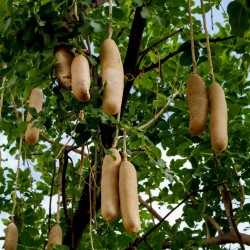
Sausage Tree Seeds (Kigelia...
Pret
2,05 €
(SKU: T 81)
Seeds Gallery EU,
5/
5
<meta http-equiv="Content-Type" content="text/html; charset=UTF-8" />
<h2><strong>Sausage Tree Seeds (Kigelia pinnata)</strong></h2>
<h2><span style="color: #ff0000;"><strong>Price for Package of 5 seeds.</strong></span></h2>
<p>Kigelia is a genus of flowering plants in the family Bignoniaceae. The genus consists of only one species, Kigelia africana, which occurs throughout tropical Africa, from Eritrea and Chad south to northern South Africa, and west to Senegal and Namibia. Common in India, with many medicinal uses, the species's distribution is most certainly anthropogenic. The sausage tree grows a fruit that is up to 2 feet long, weighs about 15 lbs, and looks like a sausage.</p>
<p>The genus name comes from the Mozambican Bantu name, kigeli-keia, while the common names sausage tree and cucumber tree refer to the long, sausage-like fruit. Its name in Afrikaans worsboom also means sausage tree, and its Arabic name means "the father of kit-bags".</p>
<p><strong>Habitat</strong></p>
<p>It is a tree growing up to 20 m (66 feet) tall and it typically has spreading branches. The bark is grey and smooth at first, peeling on older trees. It can be as thick as 6 mm on a 15-cm diameter branch. The wood is pale brown or yellowish, undifferentiated and not prone to cracking.</p>
<p><strong>Foliage</strong></p>
<p>The tree is evergreen where rainfall occurs throughout the year, but deciduous where there is a long dry season. The leaves are opposite or in whorls of three, 12 to 20 inches (30–50 cm) long, pinnate, with six to ten oval leaflets up to eight inches (20 cm) long and 2.25 inches (6 cm) broad; the terminal leaflet can be either present or absent.</p>
<p><strong>Flowers</strong></p>
<p>The flowers (and later the fruit) hang down from branches on long flexible stems (2–6 metres long). Flowers are produced in panicles; they are bell-shaped (similar to those of the African tulip tree but broader and much darker and more waxy), orange to maroon or purplish green, and about four inches (10 cm) wide. Individual flowers do not hang down but are oriented horizontally.</p>
<p><strong>Fruit</strong></p>
<p>The fruit is a woody berry from 12 to 39 inches (30–100 cm) long[3] and up to seven inches (18 cm) broad, but eight inches (20 cm) has been reported.[4] Typically it weighs between 11 and 22 pounds (5 and 10 kg) but occasionally up to 26 pounds (12 kg),[5] and hangs down on long, rope-like peduncles. The fruit pulp is fibrous, containing many seeds.</p>
<p><strong>Species associations</strong></p>
<p>Some birds are attracted to the flowers and the strong stems of each flower make ideal footholds. Their scent is most notable at night indicating that they are adapted to pollination by bats, which visit them for pollen and nectar. The flowers also remain open by day however, and are freely visited by many insect pollinators, particularly large species such as carpenter bees. The fruit are eaten by several species of mammals, including baboons, bushpigs, savannah elephants, giraffes, hippopotamuses, monkeys, and porcupines. The seeds are dispersed in their dung. The seeds are also eaten by brown parrots and brown-headed parrots, and the tree's foliage by elephants and greater kudu (Joffe 2003; del Hoyo et al. 1997). Introduced specimens in Australian parks are very popular with cockatoos.</p>
<p><strong>Cultivation and uses</strong></p>
<p>The fresh fruit is poisonous and strongly purgative; fruit are prepared for consumption by drying, roasting or fermentation (Joffe 2003; McBurney 2004). Kigelia is also used in a number of skin care products. In Botswana, the timber is used for makoros, yokes and oars.</p>
<p>The hard shell (skin) of the fruit can be hollowed out, cleaned, and made into useful, durable containers of varying sizes.</p>
<p>The tree is widely grown as an ornamental tree in tropical regions for its decorative flowers and unusual fruit. Planting sites should be selected carefully, as the falling fruit can cause serious injury to people and damage vehicles parked under the trees.</p>
<p>In Central Kenya, especially among the Agikuyu and the Akamba, the dried fruits are used to make an alcoholic beverage (muratina in Kikuyu, kaluvu in Kamba), which is a core component in cultural events in Central Kenya. The fruit is harvested then split into two along the grain, then dried in the sun. The dried fruit is then treated with bee pollen and honey. The treated fruit (miatine) is then used in fermentation process in making of sweet beer.</p>
T 81 (5 S)


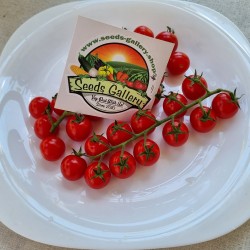
BLUE ANGEL Vine Cherry...
Pret
1,75 €
(SKU: VT 5)
Seeds Gallery EU,
5/
5
<h2><strong>BLUE ANGEL Vine Cherry Tomato Seeds</strong></h2>
<h2><span style="color: #ff0000;"><strong>Price for Package of 10 seeds.</strong></span></h2>
<p>Tomato variety from Austria. Super sweet perfectly round fruits are 2,5 - 3 cm in diameter, and have a weight of 10 grams and 14 fruits per cluster. Plants are very robust and do not need special care.</p>
<p>Vine tomatoes have a unique aromatic-sweet taste, which makes them particularly popular. Due to the panicle, they retain their strong tomato aroma over a longer period of time.</p>
VT 5 (10 S)

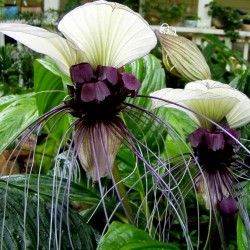
White Bat Flower Seeds...
Pret
2,85 €
(SKU: F 66 W)
Seeds Gallery EU,
5/
5
<h2><span style="font-size:14pt;"><strong>White Bat Flower Seeds (Tacca chantrieri)</strong></span></h2>
<h2><span style="color:#ff0000;font-size:14pt;"><strong>Price for Package of 4 seeds.</strong></span></h2>
<p>Tacca chantrieri, the black bat flower, is a species of flowering plant in the yam family Dioscoreaceae. Tacca chantrieri is an unusual plant in that it has black flowers. These flowers are somewhat bat-shaped, are up to 12 inches across, and have long 'whiskers' that can grow up to 28 inches. There are ten species in the genus Tacca. One of these, T. integrifolia, is commonly called the "white bat plant." T. integrifolia is similar to T. chantrieri, but has white bracts which are veined purple. T. integrifolia is larger than T. chantrieri, reaching up to four feet in height (almost twice the size of T. chantrieri at a height of 24"-36").</p>
<p>Tacca chantrierei is native to tropical regions of Southeast Asia including Thailand, Malaysia, and southern China: particularly Yunnan Province. They are understory plants, so they prefer shade (at least 60%). They grow best in well-drained soil with good air circulation, but they prefer high humidity, and need a lot of water. They are hardy to USDA zones 11, above 4.5 °C (40 °F).</p>
F 66 W


Transparent Clear Test Tube...
Pret
0,28 €
(SKU: PE 3 (2ml))
Seeds Gallery EU,
5/
5
<h2><span style="font-size: 14pt;"><strong>Transparent Clear Test Tube With lid 2 ml </strong></span></h2>
<h3><span style="color: #ff0000; font-size: 14pt;"><strong>Price is for 1 Test Tube.</strong></span></h3>
<p>Ideal for storing seeds or some other things.</p>
<p>The lid is perfectly closed and therefore, so you can hold also liquids.</p>
<p>Disposable plastic centrifuge tube with cap.</p>
<p>Made of pp material, heat resistance up to 150 degrees, no bubble without impurities.</p>
<p>Pointed bottom, flexible cover, easy to open.</p>
<p><strong>Specification:</strong><br><span>External Diameter: 13cm/0.51"</span><br><span>Inner Dia: 0.9cm/0.35"</span><br><span>length: 4.2cm/1.65"</span><br><span>Size: L 1.65" x W 0.75"</span><br><span>Material: Polypropylene</span><br><span>Color: Transparent</span></p>
<script src="//cdn.public.n1ed.com/G3OMDFLT/widgets.js"></script>
PE 3 (2ml)

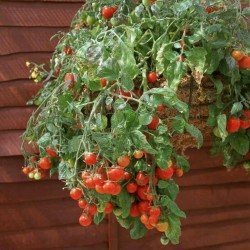
Red & Yellow Tumbling Tom...
Pret
1,55 €
(SKU: VT 145)
Seeds Gallery EU,
5/
5
<h2><strong>Red & Yellow Tumbling Tom Tomato Seeds</strong></h2>
<h2><span style="color:#ff0000;"><strong>Price for Package of 5 seeds.</strong></span></h2>
<p>Trade flowering hanging baskets for pretty-as-a-picture trailing tomatoes. Tumbling Tom Red plants cascade from hanging baskets, tall containers, or window boxes, and when they’re loaded with sparkling red fruit, the effect is striking. Anticipate a harvest of up to four pounds of tomatoes per plant, with new fruit ripening throughout the summer. These plants have a trailing growth habit, so they don’t need staking. Tuck one to two into a tall pot or large hanging basket. Resistant to fusarium wilt, verticillium wilt, and nematodes.</p>
<p>Light Full sun</p>
<p>Fruit weight 15-20g</p>
<p>Matures 63 to 70 days</p>
<p>Plant spacing 10 inches apart</p>
<p>Plant size 30-50 cm</p>
<p>Plant type compact determinate (cascading)</p>
VT 145 Y (5 S)





